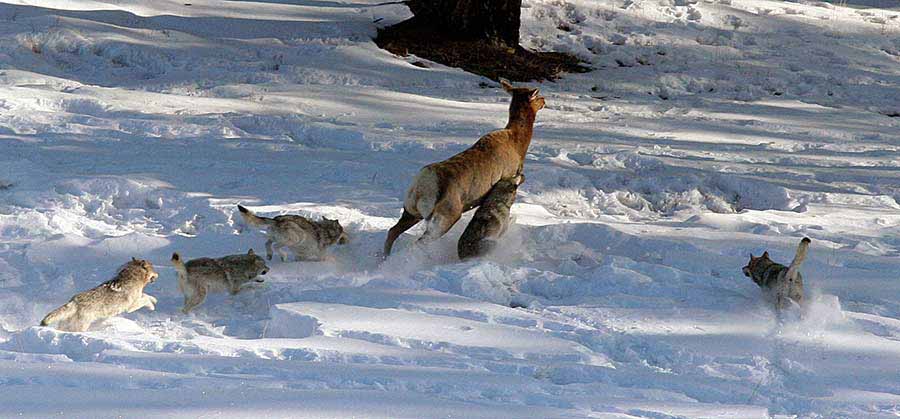
Wolves in Yellowstone National Park chase after an elk in deep snow. (Dan Stahler/NPS)
By Kelsey Dayton
Wolves are not responsible for low pregnancy rates in elk, according to a new study published today in the scientific journal Ecology Letters.
The research, led by recent University of Wyoming Phd graduate Arthur Middleton, shows that elk don’t respond frequently enough to wolves to impact body fat and pregnancy rates. Wolves’ impact on elk populations is limited to direct predation, not harassment or stress that leads to lower pregnancy rates or poor body composition.
Middleton was studying the Clarks Fork elk herd near Cody, Wyo., just east of Yellowstone National Park. He and other scientists noticed the dramatically low pregnancy rate of the herd. The first year it was only 59 percent. The average of that year and the subsequent three years was about 70 percent. A normal pregnancy rate for Rocky Mountain Elk is about 90 percent, Middleton said.
“That was very eye opening,” Middleton said. “We knew we had something we needed to understand better.”
Middleton, along with the Wyoming Cooperative Fish and Wildlife Research Unit, a U.S. Geological Survey program housed at the University of Wyoming, wanted to know if the low pregnancy rate could be due to the wolves in the area.
Working closely with Wyoming Game and Fish and the U.S. Fish and Wildlife Services, Middleton and researchers fitted about 100 elk with GPS collars from 2008 to 2010.They also tracked wolves from the Sunlight, Hoodoo, Beartooth and Absaroka wolf packs known to hunt the Clarks Fork herd.
The question about how many elk calves were getting eaten and by what had already been studied, including recent research linking the decline in Yellowstone cutthroat trout in Yellowstone Lake to bears killing more calves.
“We knew what was killing elk calves, we wanted to find out why more weren’t being born,” he said.
The GPS devices, which provided locations for the wolves and elk every three hours, allowed researchers to monitor how often the animals interacted and how they interacted, the movement rates and change in habitat use of the elk when wolves were in the vicinity. Even though elk responded to wolves in clear ways — they moved away from wolves and became more vigilant, they didn’t eat less or move into the trees, Middleton said. They really only responded when the wolves came within 1 kilometer, or a little more than half a mile. The responses were too weak and infrequent to have a cumulative effect on pregnancy or body fat.
Elk that encountered wolves more frequently were not less fat or less likely to be pregnant, the study said.
This finding differs from some previous studies that indicated wolves influence elk behavior strongly enough to contribute to region-wide declines in calf production. The study casts additional doubt on the idea that wolf reintroduction has caused “behaviorally mediated trophic cascade” in the greater Yellowstone ecosystem, which prompts elk to alter foraging behavior.
“This doesn’t mean that wolves don’t affect elk,” Middleton said. “It suggests the effects are limited to killing and eating elk.”
In recent years there has been a big shift eastward of the elk population near Cody. Part of what the studied showed was wolves weren’t forcing the elk to move.
Wolf reintroduction is often called a natural experiment, but in true experiments the other variables are controlled, Middleton said. Changes in behavior or in the ecosystem aren’t necessarily related to wolves because there are other changes happening as well. The low pregnancy rates are most likely due to drought, but more research is needed, including a look at a more regional scale, Middleton said.
It’s early to say exactly what the research means for elk population numbers, but if the pregnancy rates remain as low as shown in the study there could be a big impact, Middleton said. The pregnancy rate is important in itself, but also in what it says about the animals’ overall health. Low pregnancy rates can be a flag for nutrition issues, which can mean lower calf birth rates and growth rates and impact overall population performance.
The research is important to future wildlife management, said Steve Kilpatrick, executive director of the Wyoming Wildlife Federation. “We can either accept (the low pregnancy rates) and just go on and harvest fewer elk and just keep adjusting seasons so we don’t deplete the herd … or we can say ‘hey, what is causing this?’” he said.
Large predators, like grizzly bears and wolves, elicit emotional responses from people who are quick to attribute and blame changes on the animals. Studies like this, through the University of Wyoming, show what is really happening in the ecosystem. Kilpatrick said he was not surprised to learn the low pregnancy rates were not due to stress from wolves. Other animals, like moose, are also experiencing low pregnancy rates. It speaks to a larger issue about nutrition and drought, he said.
The study shows the connectivity between nutrition and pregnancy rates — something livestock managers have understood for years, but was illuminating to wildlife managers, Kilpatrick said.
The body condition and pregnancy rate shows something is happening nutritionally with the animals.
“They’re just not getting good groceries anymore,” he said.
Kilpatrick said more research is needed to see if elk are benefiting and utilizing habitat improvements and if there is a way to better manage for vegetation.
Reprinted with permission from “Peaks to Plains,” a WyoFile.com blog focusing on Wyoming’s outdoors and communities. Kelsey Dayton is a freelance writer based in Lander. She has been a journalist in Wyoming for seven years, reporting for the Jackson Hole News & Guide, Casper Star-Tribune and the Gillette News-Record. Contact Kelsey at kelsey.dayton@gmail.com. Follower her on twitter @Kelsey_Dayton.
